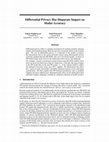Talks by Alexandros Antonaras
With citizens nowadays demanding responsible business behaviour, corporations and their leaders h... more With citizens nowadays demanding responsible business behaviour, corporations and their leaders have become aware of the crucial role of trust, quality and integrity in seeking performance excellence, profit and sustainable growth. According to Aristotle, leadership, and as a result business behaviour, pre-assumes the existence of three elements, Ethos, Logos (logic) and Passion for Ethics. Therefore, to bridge the gap, a Business Ethics Model has been developed by EBEN GR in 2007 aiming to align the continuous upgrading of quality and excellence in a business environment with ethical governance and corporate social responsibility. This article analyses the EBEN GR Business Ethics Model and investigates the effect of adopting it in an effort to reach sustainable excellence through the implementation of the EFQM Excellence Model.
The shift in agricultural production and agribusiness may be a solution in reducing unemployment ... more The shift in agricultural production and agribusiness may be a solution in reducing unemployment and particularly that of young people which is dramatically high in several European countries that are experiencing the negative consequences of the recent global financial crisis that led to a dramatic decline in their GDP per capita and has affected all sectors of economic activity, including agriculture. The overall scope of this chapter is to present an Agricultural Entrepreneurship and Social Innovation Framework that can lead to a new business model with social aspects, contribute to the economic growth and sustainability and hence combat the phenomenon of unemployment and poverty in rural areas that have been seriously affected by the recent financial crisis.
Papers by Alexandros Antonaras

IGI Global eBooks, Mar 4, 2022
Social value is created when resources, inputs, processes, or policies are combined to generate i... more Social value is created when resources, inputs, processes, or policies are combined to generate improvements in the lives of individuals or society as a whole. It is crucial for any organization to be able to demonstrate the value it creates by its very existence. Corporate social responsibility (CSR) has never been more important. Citizens nowadays demand a responsible business behavior from all kinds of organizations, corporations, and their leaders who have become aware of the crucial role of social responsibility in seeking performance excellence and sustainable growth. This chapter introduces the concept of CSR and explains its importance providing the historical background that made it synonymous to sustainability. The benefits resulting from CSR are briefly presented while the main recent developments in the area of CSR and sustainability are analyzed. Particularly, emphasis is given on the 2030 Agenda, the European Directive (2014/95/EU) on non-financial reporting, and the recent trends for socially responsible investments.
Growing on Ethics Conference for Responsible Entrepreneurship, Sep 23, 2015
Advances in Business Strategy and Competitive Advantage
The shift in agricultural production and agribusiness may be a solution in reducing unemployment ... more The shift in agricultural production and agribusiness may be a solution in reducing unemployment and particularly that of young people which is dramatically high in several European countries that are experiencing the negative consequences of the recent global financial crisis that led to a dramatic decline in their GDP per capita and has affected all sectors of economic activity, including agriculture. The overall scope of this chapter is to present an Agricultural Entrepreneurship and Social Innovation Framework that can lead to a new business model with social aspects, contribute to the economic growth and sustainability and hence combat the phenomenon of unemployment and poverty in rural areas that have been seriously affected by the recent financial crisis.

Due to the current market pressures and the cruel competition for both students and resources cau... more Due to the current market pressures and the cruel competition for both students and resources caused by the rapid expansion of colleges and universities worldwide, higher education institutions (HEIs) are gradually developing and implementing more market-oriented strategies, orientations and policies. Meeting customer demands and expectations as well as maintaining effective relationships with them, is nowadays high in priority as an important determinant of superior overall institutional performance and as a major source of profitability and sustainable competitiveness. The majority of contemporary leading HEIs are increasing the emphasis given on identifying the " characteristics " of a quality university as perceived by their most important internal stakeholders, students. Quality constitutes a key success factor for HEIs, since it strengthens student attraction and retention, enhances both student and alumni satisfaction, improves graduate employability, reinforce inst...

World Review of Entrepreneurship, Management and Sustainable Development, 2018
Contemporary organisations are paying a growing attention to the social impact of their business ... more Contemporary organisations are paying a growing attention to the social impact of their business activities in pursuit of favourable economic outcomes and sustainable competitiveness. Universities increasingly enact corporate social responsibility strategies with the aim of strengthening both their customer and employee satisfaction. However, since organisations have limited resources to invest in CSR activities, they need to prioritise their CSR objectives and this can be accomplished by taking the expectations of their stakeholders into consideration. Based on a stakeholder approach, a survey was conducted with the aim of assessing main stakeholders' expectations and perceptions concerning CSR practices implemented by universities. Moreover, in order to address the absence of practical tools and models for corporate responsibility management, the present study led to the development of a conceptual framework for crafting and implementing a CSR strategy at university level.
Entrepreneurial Challenges in the 21st Century, 2016

Changes and modifications in forms, fits, materials, dimensions, functions, etc. of a product or ... more Changes and modifications in forms, fits, materials, dimensions, functions, etc. of a product or part are referred to as product design changes before the design is released, or engineering changes (ECs) after the design is released. An EC usually includes a resulting series of downstream changes along the product development process. Organisational, technological and operational changes are often causes for ECs [1]. ECs are a very significant issue in any product development process and especially in any new product development process. The scope of this paper is to report on the use of a specific business process modelling and simulation technique, namely System Dynamics, in order to develop an efficient and effective Engineering Change Management System. System Dynamics is a modelling technique that is especially suited for modelling, simulating and analysing the behavioural aspects of a system, i.e. the way that the system elements interact and influence each other to generate overall system behaviour. In terms of the New Product/Service Introduction (NP/SI) process, such an analysis can reveal positive or negative feedback loops in the process, thereby allowing managers to understand the likely impact of ‘local’ changes on overall process cost, time, and perceived quality. To the best of our knowledge this is the first attempt to use the methodology of System Dynamics in order to develop an Engineering Changes Management System. The primary aim is to simulate the NP/SI process of two particular companies in Greece and get an indication of the relationship between cost, time and quality. Furthermore, by inserting disturbances into the models and then simulating the NP/SI processes, it is possible to get an overview of the effects of ECs throughout this process. The results of the simulation process together with the ECs background, can provide the basis for developing an Engineering Change Management System, which when managed effectively can lead to an improved environment for product innovation, and provides a favourable opportunity for increased sales and profits.

Good quality leads to increased productivity and reduced costs, which eventually, through increas... more Good quality leads to increased productivity and reduced costs, which eventually, through increased customer satisfaction, lead to increased sales, profits and survival in today's highly competitive market. Some people say quality is free. Others claim it requires an investment. A more accurate assessment is that quality does require an investment but it pays dividends that far outweigh that investment. Early investment in quality avoids excessive costs downstream in the process. One such investment in a quality cost measurement system is considered essential, especially for companies that have no such a system and are continuously looking for means of improving the overall quality process within their operations. This paper discuses three alternative quality cost measurement systems, presents the results of a real case from Greece and explains the benefits and associated risks.
In order to understand attitudes towards work-related ethics, a survey was conducted among employ... more In order to understand attitudes towards work-related ethics, a survey was conducted among employees in two European countries, Greece and Cyprus, facing similar financial problems and requiring financial assistance from the European Commission, the ECB and the IMF. An attempt was also made to investigate whether such differences, if any, were linked to differences in employee age, gender, job position, nationality and organization’s size. The findings indicate that no significant differences among employees exist with regard to employee age and organization’s size. Significant differences were found between the two samples regarding gender, job position and nationality. It is recommended that ethics education be integral to a business curriculum and that teaching methodologies explore ways in which to develop moral reasoning in students.

Verslo ir teisės aktualijos, 2010
ABSTRACT With citizens nowadays demanding a responsible business behavior from all kinds of orga-... more ABSTRACT With citizens nowadays demanding a responsible business behavior from all kinds of orga-nizations (for-profit and not-for-profit), corporations and their leaders have become aware of the crucial role of Social Return on Investment in seeking performance excellence and sustainable growth. Due to the absence of appropriate metrics to measure social value cre-ation, the work done in that area by both the not-for-profit sector and the for-profit sector is grossly undervalued and thus the social value created by the investment is not known. Therefore, to bridge the gap, a Business Ethics Model was developed by the Greek Chapter of the European Business Ethics Network (EBEN GR) in 2007 aiming to align the continuous upgrading of quality and excellence in the business environment with ethical governance and corporate social responsibility. This paper presents the EBEN GR Business Ethics Mo-del and investigates how its implementation can enable organizations to reach sustainable excellence. It also explains how the EBEN GR Business Ethics Excellence Model can be used as an alternative method for measuring an organization's social return on investment and studies the initial findings of its implementation in Greece and Cyprus.
The aim of this paper is to report on the use of a specific business process modelling technique,... more The aim of this paper is to report on the use of a specific business process modelling technique, namely System Dynamics, in order to model the generic structure of the New Product/Service Introduction(NP/SI) process in organisations. System Dynamics is a simulation technique that is especially suited for modelling and analysing the behavioural aspects of a system, i.e. the way that the system elements interact with and influence each other to generate overall system behaviour. In terms of the NP/SI process, such an analysis can reveal positive or negative feedback loops in the process, thereby allowing managers to understand the likely impact of ‘local’ changes on overall process cost, time, and perceived quality.











Uploads
Talks by Alexandros Antonaras
Papers by Alexandros Antonaras
In contemporary highly turbulent, fiercely competitive and volatile business world, organizations’ both internal and external operating environment, is undergoing consecutive alterations forcing them to continuously adapt to new conditions. It seems that nowadays the only constant fact in organizations’ reality is the existence of ceaseless changes and the consequent imperative need for them to effectively respond to these changes. It becomes increasingly important for organizations to adapt quickly to alterations and learn how to be innovative in order to remain competitive. Their sustainability and long-term well-being lie in their critical ability to continuously innovate with the aim of meeting the changeable demands of their unstable operating environment. Therefore, organizations have entered a new era in which the notion of serial entrepreneurship becomes more crucial than ever. Contrary to a typical entrepreneur who comes up once with an idea, launches a new business and focuses on its day to day functioning, a serial entrepreneur continuously grasps market opportunities, generates new ideas and starts new businesses by utilizing his/her enriched knowledge base and accumulated experience. Fully aware of market volatility, serial entrepreneurs dominate the dynamics of their industries by effectively leveraging organizational and network capabilities to achieve increased venture performance.